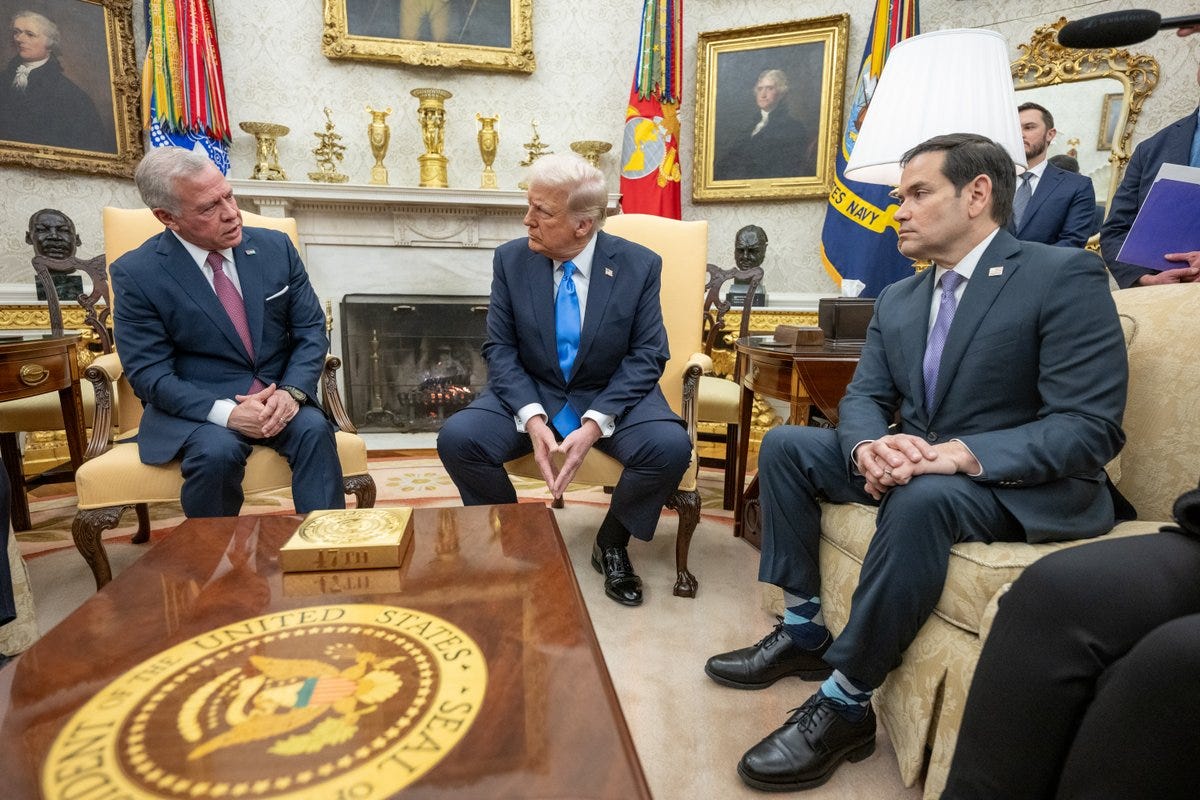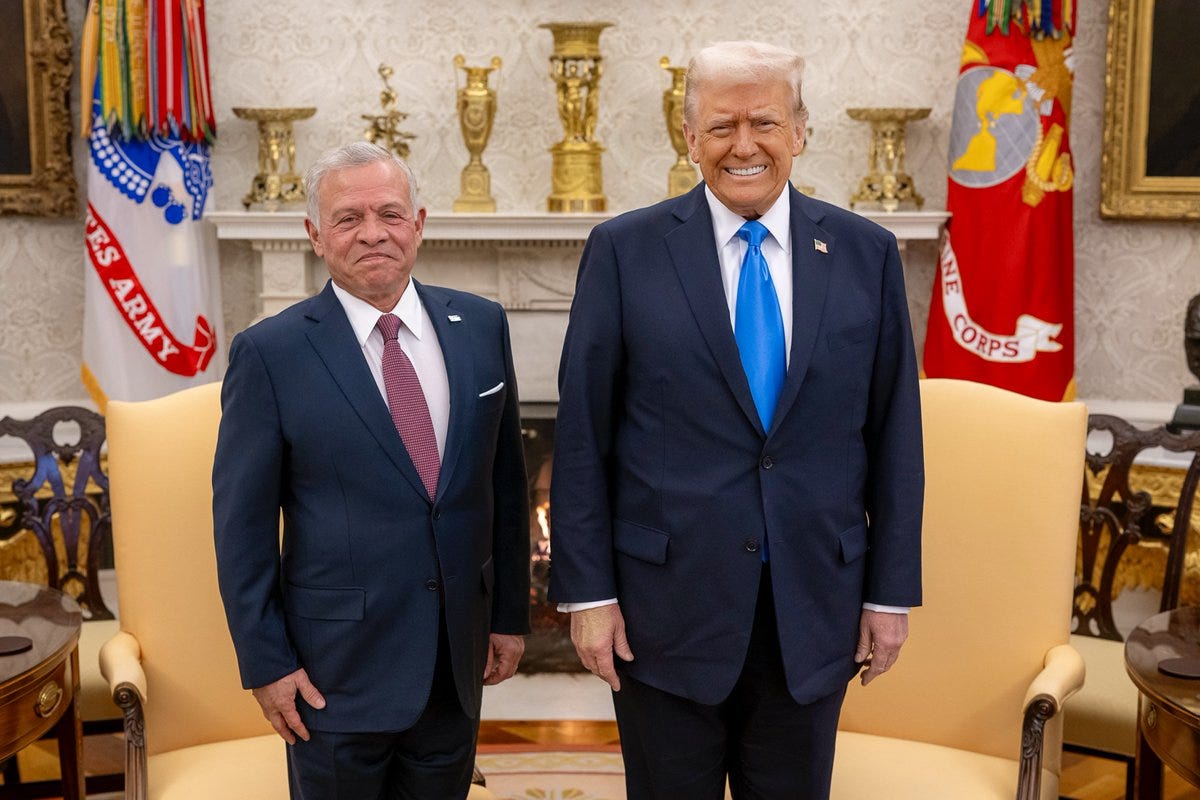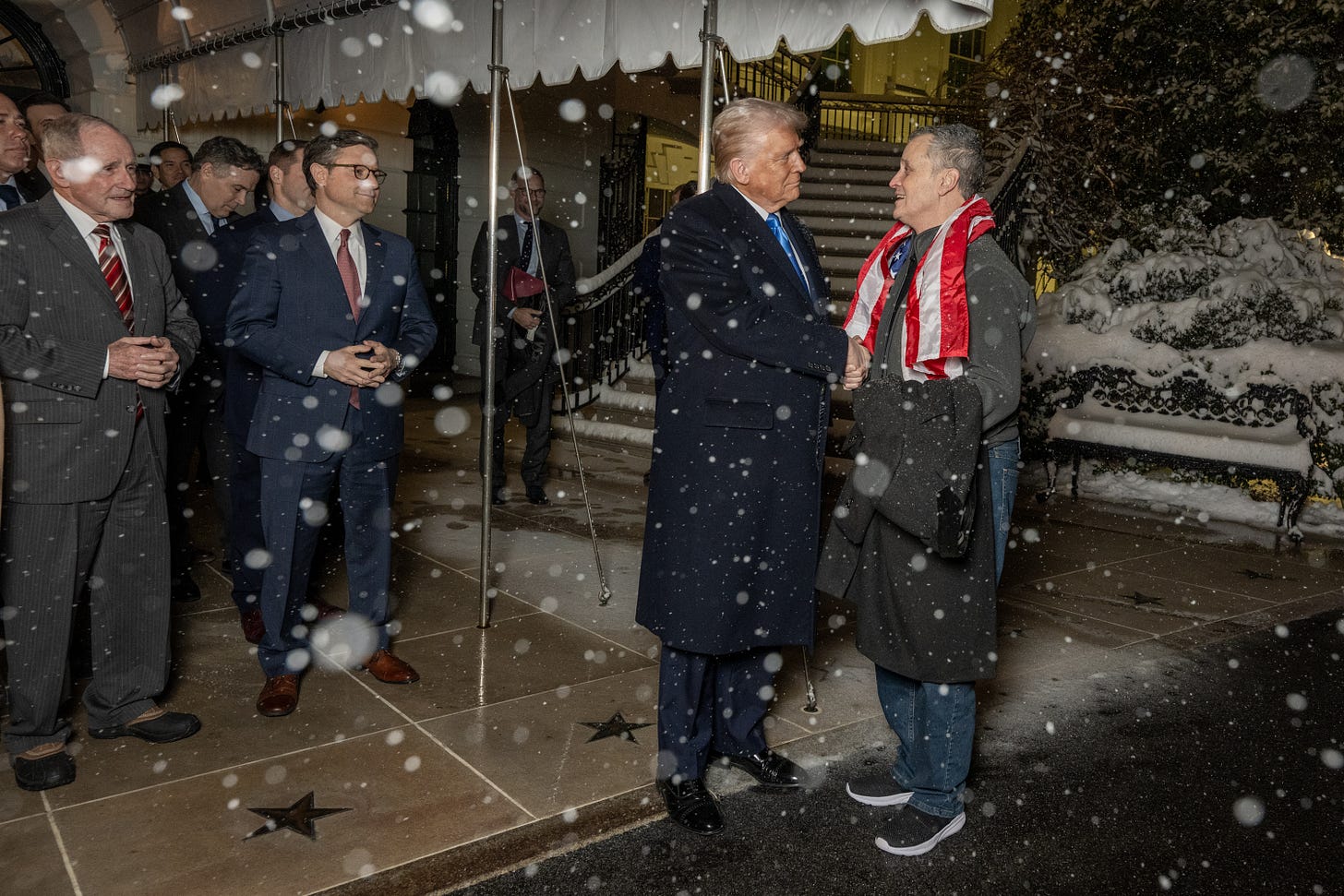How to Win Friends and Influence Trump
World leaders approach the new president with an old playbook.
Good morning! It’s Wednesday, February 12, 2025. Election Day 2025 is 266 days away. Election Day 2026 is 630 days away.
I’m trying something new this morning! For the first time ever, I recorded today’s newsletter so you can listen to it, narrated by me, instead of reading it. You can listen by clicking the play button above. This is something I’m experimenting with — please let me know in the comments or over email what you think!
Now onto today’s news…

One of the more interesting subplots in the Trump-Musk relationship, which I wrote a bit about yesterday, has been the brief presence of OpenAI CEO Sam Altman as a character.
Altman and Musk are former allies, having co-founded OpenAI (the maker of ChatGPT) together in 2015. But their partnership has long since turned south: Musk left the firm in 2018 and sued the company last year. Earlier this week, it was reported that Musk is leading a $97.4 billion bid to buy OpenAI, which sparked yet another Twitter spat between the two tech luminaries.
Trump got stuck in between this feud his very first week back in office, after hosting Altman at the White House for a $500 billion AI infrastructure announcement. Musk couldn’t help but get a poke in at his rival, seeding doubt online that Altman had sufficient funding for the project.
It was unusual behavior, to say the least, for a White House staffer to publicly lash out at a project that the president had personally announced. Trump let it slide: “He hates one of the people. But I have certain hatreds of people too,” the president said of Musk, amusingly, when asked about the dispute.
But he also didn’t take Musk’s side: the White House stood by Altman and emphasized its faith in the OpenAI project. How did Altman, a Biden donor and onetime Trump critic, possibly manage to outfox Musk, one of Trump’s closest allies and advisers?
The answer was provided in a recent New York Times story, which is worth reading even if you couldn’t care less which AI billionaire has the ear of the president.
It’s worth reading because it gives insight into how all manner of people — from CEOs to foreign leaders — try to ingratiate themselves with Trump. Per the Times, Altman followed a pretty well-worn playbook:
In a meeting during the campaign, OpenAI executives tried to appeal to Trump’s real estate background by focusing on “language around construction and infrastructure” when discussing their need for data centers.
They also tried to impress him by showing him new technology, an AI video generator that hasn’t been released yet.
Then, in a phone call during the transition, Altman sought to appeal to Trump’s “love of a big story and of a big deal.” He told Trump, according to the Times, “that the tech industry would achieve artificial general intelligence — the hypothetical moment when technology matches human intelligence — during the Trump administration.” If he wanted the U.S. to achieve AGI before China (thus landing Trump in the history books as the president who helped make that moment possible), he should back OpenAI, Altman said.
Finally, he used flattery. “We wouldn’t be able to do this without you, Mr. President,” Altman gushed during the White House event, even though the project had been in the works for months. Altman and his partners purposefully timed the announcement so that Trump could take credit for the deal in his opening days in office.
The most interesting thing about this strategy is how uninteresting it is. I don’t run one of Silicon Valley’s hottest startups, but I could have told you without reading the New York Times that these steps would be basically the best ones to use to win over Donald Trump. You probably aren’t a tech billionaire either, but I’m guessing you could have sketched out this playbook by yourself, too.
Not only are the steps needed to win over Trump so well known that stories like this regularly get published. The steps are so well known that stories like this regularly get published and when they do, we all just shrug, because they are so non-revelatory. Everyone already knows.
It might seem like, eventually, this strategy would stop working precisely because it so public: so many people would be using it, you might think, that it would start losing its effectiveness. If so, we have yet to reach that point.
I’m not bringing all this up to talk about Trump’s relationship with Silicon Valley, although that’s obviously an important topic. Rather, I think the OpenAI episode — and the playbook employed by Altman — offer a revealing segue into Trump’s recent dealings with the only people more powerful than tech CEOs (or, at least, they used to be): Trump’s fellow heads of state.
It’s clear that one part of being president that Trump really loves is hosting foreign leaders in the Oval Office. During his first term, world leaders got used to the routine: long handshake, followed by a long period of sitting silently while Trump talks to reporters.
Since taking office last month, Trump has already hosted leaders like Japanese Prime Minister Shigeru Ishiba and Israeli Prime Minister Benjamin Netanyahu. The parade will continue later this week with Indian Prime Minister Narendra Modi on Thursday and then next month with United Kingdom Prime Minister Keir Starmer.
Trump obviously enjoys the pomp and circumstance of these visits; a White House official told the Washington Examiner that they also guarantee twice as many cameras in the Oval, since foreign leaders bring their own press corps (“that’s more eyeballs on the president”) and the ability to try to move media attention away from controversies of the day and towards whatever topic Trump wants to talk about.
Yesterday, it was King Abdullah II of Jordan’s turn in the hot seat. The king looked visibly uncomfortable as Trump described his plan for the U.S. to take over Gaza, which flies in the face of what Abdullah has spent years advocating.
The Palestinians would live “beautifully in another location,” Trump said, adding: “They don’t want to be on the Gaza Strip.” Where would they go? a reporter asked. “I believe we’ll have a parcel of land in Jordan,” Trump explained. “I believe we’ll have a parcel of land in Egypt. We may have someplace else.”
Not even five months ago, Abdullah took to the United Nations to criticize “those who continue to propagate the idea of Jordan as an alternative homeland” for the Palestinians. “Let me be very, very clear,” he said then. “That will never happen. We will never accept the forced displacement of Palestinians, which is a war crime.”
But Abdullah didn’t say that to the cameras on Tuesday. Instead, he appealed to Trump’s ego: “Mr. President, I truly believe that with all the challenges that we have in the Middle East, that I finally see somebody that could take us across the finish line to bring stability, peace, and prosperity to all of us in the region.” (That is the only quote from the entire meeting that the White House put on X).
He came with a deliverable — another favored tactic for dealing with Trump — announcing that Jordan would take in 2,000 sick Palestinian children. “That’s really a beautiful gesture,” Trump responded. “That’s really good, and we appreciate it.” Later, when asked about his views on Trump’s plan, the king pivoted, once again bringing up the 2,000 children.
Later, on X, Abdullah made his opposition to Trump’s proposal clear: “I reiterated Jordan’s steadfast position against the displacement of Palestinians in Gaza and the West Bank,” the king wrote.
But, in the room, his dodge seemed to work. On Monday, Trump raised the possibility of withholding aid to Jordan and Egypt if the countries don’t allow Gazans to relocate there. By Tuesday, Trump either didn’t want to spark such a confrontation face-to-face, or he was won over by Abdullah’s comments. “I don’t want to say that,” Trump said when he was asked if he was still considering cutting off aid, “because we’ve had such a good relationship and we’re doing so well, just in the short time that we’ve been talking.”
He added: “The king just made a statement — I didn’t ask him to do that — about literally saving 2,000 young children from the Gaza Strip.”
These same sorts of patterns have played out throughout Trump’s second term. “I was so excited to see such a celebrity on television,” Ishiba, the Japanese leader, said while meeting Trump. “On television he is frightening, and he has a very strong personality, but when I met with him, actually, he was very sincere and very powerful, and with strong will for the United States.”
“You are the greatest friend Israel has ever had in the White House,” said Netanyahu.
Both leaders left the White House satisfied: Trump has not (yet) announced heightened tariffs on Japan; Netanyahu was delighted by Trump’s surprise Gaza announcement.
As with his first term, Trump’s frenzied approach has yielded some successes (helping negotiate an Israel/Hamas ceasefire; pressuring Colombia to accept migrants), while also creating fresh diplomatic crises in other areas (the Middle East was stunned by his Gaza plan; his further expansionist rhetoric has Canadians suddenly booing America at hockey games.)
Across several disputes, leaders have generally understood that the way to de-escalate is to hand Trump something that allows him to declare victory: both Canada and Mexico, for example, were able to avert new tariffs by offering the president relatively small concessions.
The greatest test of Trump’s foreign policy will be whether he is able to end the wars in Ukraine and Gaza, which he repeatedly promised during the campaign. (In fact, he is now 23 days late on his promise to end the Ukraine war.)
In both conflicts, leaders are racing to ingratiate themselves with Trump by offering him wins. Trump told Fox News that Ukraine has “essentially agreed” to give $500 billion in rare earth minerals to the U.S. in exchange for continued military aid. Treasury Secretary Scott Bessent has been dispatched to finalize the deal with President Volodymyr Zelensky.
Russia, meanwhile, released the American schoolteacher Marc Fogel on Tuesday, after detaining him for more than three years over a minor medical marijuana infraction. The move “serves as a show of good faith from the Russians and a sign we are moving in the right direction to end the brutal and terrible war in Ukraine,” national security adviser Mike Waltz said, explicitly linking the gesture to the war. “I think this…could be a big, important part in getting the war over,” Trump said of the prisoner exchange. (At least, Russia is calling it an exchange, saying that a Russian jailed in the U.S. was released. U.S. officials have denied that.)
In Gaza, the ceasefire Trump helped broker appears to be in danger: Hamas is threatening to postpone the next hostage release after alleging that Israel violated the deal by shooting at Palestinians and delaying humanitarian aid. Trump responded by telling Hamas that “all hell” would break loose if the group does not release all the Israeli hostages by Saturday, weeks earlier than the deal calls for. (Israel has not gone quite that far, but has said it will resume fighting if the agreed-on hostages are not released by Saturday.)
Mahmoud Abbas, the leader of the Palestinian Authority (PA), appeared to be trying to lower the temperature on Monday, when he announced that the PA would back away from its longtime practice of paying stipends to the families of Palestinians involved in attacks on Israel. According to the Times of Israel, the announcement was already in the works at the tail end of Biden’s term.
Sound familiar? It’s the same strategy Altman adopted at OpenAI, sitting on a new announcement in order to curry favor with Trump by unveiling it soon after he took office.
Just as Netanyahu and Abdullah took another page from the playbook, hyperbolizing and praising Trump. And like Putin and Zelensky appealed to Trump’s sense of himself as a dealmaker and handed him wins in areas that are of special focus for him, such as natural resources or Americans detained overseas (Trump released several in his first term).
From Silicon Valley to the Middle East, the strategy for handling Trump is the exact same. The question is when — if ever — it will reach its expiration date.
More news to know
Prices climbed more than expected in January, reaching an annual inflation rate of 3% for the first time since June.
Trump and Elon Musk made a joint appearance in the Oval Office as the president signed an executive order directing executive agencies to work with DOGE.
The White House barred an Associated Press reporter from covering the event because the AP’s guidance refers to the so-called “Gulf of America” as the Gulf of Mexico.
Musk’s DOGE team announced $900 million in cuts at the Education Department, mostly aimed at terminating research contracts. Musk also triggered the firing of four FEMA officials, whom he alleged use disaster relief funds to house migrants, although the money had not been intended as disaster aid. And the USAID inspector general was dismissed after releasing a report critical of Trump.
A DOGE official was “mistakenly” and “briefly” given the ability to edit the federal payments system, the Treasury Department said in a court filing.
An appeals court rejected Trump’s request to halt the district court order pausing his administration’s attempted funding freeze.
Two top officials at the Consumer Financial Protection Bureau (CFPB) resigned on Tuesday after the Trump administration ordered the agency to stop all work. “I don’t believe in these conditions I can effectively serve in my role, which is protecting American consumers,” one wrote.
Speaking of: Elon Musk’s X launched a new payment system that likely would have sparked the CFPB’s regulatory scrutiny just one week before Musk helped shut the agency down. According to the New York Times, Musk’s moves to defang government bodies have impacted at least 11 agencies investigating his companies, including the CFPB.
Trump ally Steve Bannon pleaded guilty to defrauding donors as part of a private effort to build a border wall. The deal with New York state prosecutors included certain restrictions on Bannon, but no jail time.
The day ahead
All times Eastern.
President Trump will sign executive orders at 2:30 p.m.
The Senate will vote at 11 a.m. on confirmation of Tulsi Gabbard as Director of National Intelligence, followed by a procedural vote to advance Robert F. Kennedy Jr.’s nomination as Secretary of Health and Human Services.
The House will vote at around 4:30 p.m. on the Midnight Rules Relief Act, which would allow Congress to more easily overturn regulations submitted during the last 60 legislative days of a president’s term in office.
The Supreme Court has nothing on its schedule.






Hi Gabe. I know he is all the news all the time now but I am curious - is there news to cover that isn’t trump related? Your work is always worth reading but I am already tired of the onslaught of everything trump from everyone. Surely life and news exists outside of that … subject.
Just a thought.
Thank you for the extra work with the voiceover; appreciate it!